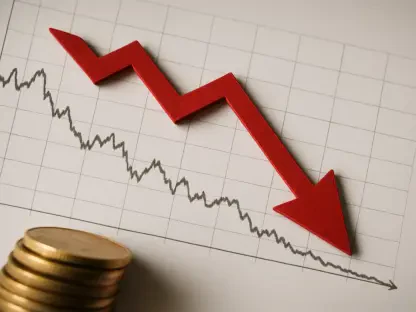The global economy has transformed considerably since the Bretton Woods system was established in 1944, initially built on fixed exchange rates which enabled profound economic integration. Although this arrangement was discarded in 1973, the movement towards globalization continued, reaching its zenith in the early 21st century. However, recent events such as the global financial crisis (GFC) of 2008, the COVID-19 pandemic, and escalating geopolitical tensions have contributed to a slowdown in globalization, severely impacting trade openness and cross-border financial assets. These disruptions are not just economic symptoms but are indicative of a deeper, systemic shift towards a fragmented global economic landscape. This evolving scenario presents notable challenges and shifting roles, particularly for institutions pivotal in maintaining global economic stability, like the International Monetary Fund (IMF).
Historical Background and Globalization Trends
In the aftermath of World War II, the IMF was instrumental in fostering global economic integration through its surveillance and lending mechanisms, which formed the foundation of the global financial safety net (GFSN). This postwar system facilitated extensive economic prosperity and significantly reduced global poverty levels, even amidst recurrent crises such as the Latin American debt crisis and the Asian financial crisis. As a lender of last resort, the IMF provided crucial financial stability and liquidity to nations in distress, thereby promoting global economic cohesion and growth.
However, the momentum towards greater globalization faced substantial challenges following the GFC, which prompted stagnation in trade openness and led to a downturn in cross-border financial assets. This trend was further exacerbated by the COVID-19 pandemic and the geopolitical upheavals, notably Russia’s invasion of Ukraine. Such events revealed the inherent vulnerabilities within the global economic system, shifting the dynamics from integration towards greater fragmentation.
Evolving Role of the IMF
Historically, one of the significant criticisms of the IMF has been the stringent conditions attached to its loans, which often caused member countries to seek alternative mechanisms to safeguard their economies. In response, nations increasingly preferred self-insurance approaches, such as bolstering their foreign exchange reserves and implementing capital flow management measures (CFMs) to shield themselves from financial volatility. These strategies became more pronounced after the GFC, signifying a growing shift away from reliance on the IMF, instead opting for autonomy and direct control over economic defenses.
The diversification within the GFSN saw a marked increase with the rise of bilateral swap lines (BSLs) and regional financing arrangements (RFAs), which emerged as critical players in providing financial stability. These alternatives to IMF resources reflected growing skepticism about the institution’s impartiality and effectiveness in averting economic instability without imposing onerous conditions. This shift underscores a broader realignment in the architecture of international financial stability, signifying a diminishing dependence on the IMF and a greater embrace of regional and bilateral solutions.
Impact of Geopolitical Tensions and Protectionist Policies
Economic disturbances such as Russia’s invasion of Ukraine compounded the trend towards increased fragmentation, spurred further by surging geopolitical tensions. In response to these challenges, many countries adopted industrial policies and imposed current account restrictions to better regulate trade flows, thereby moving further away from global economic integration. The imposition of tariffs under President Trump is a notable example of this shift towards protectionist measures, reflecting a broader trend of nations seeking to secure their economic interests in an increasingly uncertain and unstable global environment.
These protectionist measures, combined with capital controls, underscore the movement away from a seamlessly integrated global economy towards a more segmented approach. This evolving landscape raises concerns about equitable crisis support, challenging the IMF’s traditional role within the GFSN framework. The fragmentation prompted by geopolitical and protectionist strategies signals a fundamental realignment in the global economic order, emphasizing national interests over collective global stability.
Fragmentation in Global Financial Systems
The recent phase of fragmentation in both capital and trade flows signifies a significant transition from a previously integrated global economy to a more segmented framework. This new framework is characterized by the growing diversity within the GFSN, with increased significance being placed on BSLs and RFAs. These changes reflect the diminishing centrality of the IMF in the global financial system and highlight the shifting dynamics of international economic governance.
This fragmentation has far-reaching implications for global development prospects and financial stability, affecting both national economies and the broader international financial landscape. The intricate dynamics driving this fragmentation suggest heightened volatility and unpredictability in global economic interactions, challenging traditional norms and necessitating an adaptive approach to economic policy and international financial cooperation.
Policy Recommendations and Future Directions for the IMF
In the aftermath of World War II, the International Monetary Fund (IMF) played a crucial role in fostering global economic integration through its oversight and lending operations. These efforts laid the groundwork for the global financial safety net (GFSN), resulting in widespread economic prosperity and a significant reduction in global poverty levels despite crises such as the Latin American debt crisis and the Asian financial crisis. By acting as a lender of last resort, the IMF provided essential financial stability and liquidity to nations in distress, thereby promoting economic cohesion and growth worldwide.
However, the drive toward further globalization encountered significant obstacles after the Global Financial Crisis (GFC). Trade openness stagnated, and there was a decline in cross-border financial assets. This trend worsened with the COVID-19 pandemic and geopolitical disruptions, particularly Russia’s invasion of Ukraine. These events exposed the vulnerabilities of the global economic system and shifted the dynamics from integration to greater fragmentation, raising concerns about the future of global economic unity.









